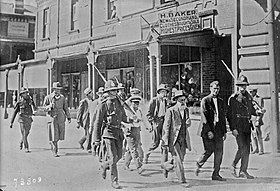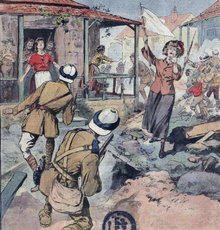| Rand Rebellion | |||||||
|---|---|---|---|---|---|---|---|
| Part of the Revolutions of 1917–1923 | |||||||
 Rebels being taken prisoner in Fordsburg | |||||||
| |||||||
| Belligerents | |||||||
|
|
| ||||||
| Commanders and leaders | |||||||
|
|
| ||||||
| Strength | |||||||
| 20,000 | |||||||
| Casualties and losses | |||||||
|
~200 killed 400+ injured 4 executed | |||||||
The Rand Rebellion (Afrikaans: Rand-rebellie; also known as the 1922 strike) was an armed uprising of white miners in the Witwatersrand region of South Africa, in March 1922.
Following a drop in the world price of gold from 130 shillings (£6 10s) per fine troy ounce in 1919 to 95s/oz (£4 15s) in December 1921, the companies tried to cut their operating costs by decreasing wages, and by weakening the colour bar by promoting cheaper black mine workers to skilled and supervisory positions.
Rebellion

The rebellion started as a strike by white mine workers on 28 December 1921 and shortly thereafter, it became an open rebellion against the state. Subsequently the workers, who had armed themselves, took over the cities of Benoni and Brakpan, and the Johannesburg suburbs of Fordsburg and Jeppe.
The young Communist Party of South Africa (CPSA) took an active part in the uprising on grounds of class struggle whilst reportedly opposing racist aspects of the strike, as did the syndicalists. The racist aspect was typified by the slogan: "Workers of the world, unite and fight for a white South Africa!" By the time that general strike was declared on 6 March, Johannesburg's elites had given up on negotiations. Reports stated that "Sabotage advocates" were "now apparently in control and had "redoubled efforts towards violence." The next day, J.L. van Eyssen, a mining engineer involved in the negotiations was informed of a " “very great increase in attempted intimidation." Gangs of white workers were halting the delivery of bread, shutting down businesses, and stopping buses that were transporting strikebreakers to the mines. Armed white men began shooting at blacks on the street. That night, the rebels bombed a mine in Primrose with dynamite.
By 8 March, there were reports that "greatly increased terrorism threatens most serious effect on position of mines." At this point, control over the rebellion had passed from workers to rural Boer commandos that had arrived in Johannesburg to bolster their cause, hoping to overthrow the government. Early that morning, one commando attacked a group of black workers, attacking them with their tools. Another commando attacked a mining compound in Primrose, killing four black workers and wounding another sixteen.
When martial law was declared on the Witwatersrand on 10 March, amid further reports of the "cold blooded murder of natives", Johannesburg was under the threat of being overrun. Prime Minister Jan Smuts sent 20,000 troops, artillery, tanks, machine-guns, snipers, and bomber aircraft to crush the rebellion. By this time, the rebels had dug trenches across Fordsburg Square and the air force tried to bomb but missed and hit a local church. Near the end of the rebellion, a pogrom broke out against blacks by enraged rebels. Lieutenant Colonel Llewellyn Andersson's role in creating the Union Defence Force was instrumental in crushing the rebellion using "considerable military firepower and at the cost of over 200 lives. Several Communists and syndicalists, the latter including the strike leaders Percy Fisher and Harry Spendiff, were killed as the rebellion was quelled by the Union Defence Force.
From 15 to 19 March 1922, South African troops cleared the areas of snipers and did house-to-house searches of premises belonging to the rebels. The rebellion was officially declared over on 18 March 1922. Before killing themselves, the two leaders of the strike, Percy Fisher and Harry Spendiff, left a note: "We died for what we believed in - the Cause."
Aftermath
Smuts' actions caused a political backlash, and in the 1924 elections his South African Party lost to a coalition of the National Party and Labour Party. They introduced the Industrial Conciliation Act 1924, Wage Act 1925 and Mines and Works Amendment Act 1926, which recognised white trade unions and reinforced the colour bar. Under instruction from the Comintern, the CPSA reversed its attitude toward the white working class and adopted a new 'Native Republic' policy.
After the strike, 18 strikers were sentenced to death for murder, of which 14 were reprieved. The four men to not be reprieved, were Carel Christian Stassen, Taffy Long, Herbert Hull, and David Lewis, were all executed by hanging at Pretoria Central Prison. Stassen was hanged on 5 October 1922, while the other three men were hanged together on 17 November 1922. He was convicted of killing two black men, John Setsuta and John McKenzie, in what witnesses said were racially motivated killings. Long was convicted of killing a police informant, while Hull and Lewis were convicted of killing a soldier. As they marched to the gallows, Long began singing the "Red Flag", the anthem of early socialists and communists in South Africa. He was joined in the song by the other two men. As they walked, all the prisoners sang with them.
In popular culture
A TV series in 8 episodes produced by the SABC in 1984 and entitled 1922, tells this part of South African history.
In Agatha Christie's The Man in the Brown Suit, published in 1924, the Rand Rebellion is mentioned both by name and as a backdrop for the mystery. Christie washes over the specifics and uses the Rebellion as nothing more than a minor inconvenience for her characters.
In Wilbur Smith's A Sparrow Falls one of the principal characters becomes embroiled with some of the organisers of the Rand Rebellion in Fordsburg and fictionalised descriptions of some of the first skirmishes with the authorities are described.
Bibliography
- Jeremy Krikler, Rand Revolt: The 1922 Insurrection and Racial Killings in South Africa, Jonathan Ball Publishers SA, 2006, ISBN 978-186842-189-3
- Wessel Pretorius Visser, A History of the South African Mine Workers' Union, 1902-2014, Edwin Mellen Press, 2016, ISBN 978-1-4955-0460-0
See also
- Maritz rebellion
- Benjamin Jennings Caddy
- Jacob van Deventer
- Ernest Glanville
- Cape Mounted Riflemen
- Light Horse Regiment
- South African Air Force
References
- Bendix, S. (2001). Industrial relations in South Africa. Claremont: Juta. p. 59. ISBN 978-0-7021-5279-5.
- "Fifty fighting years – chapter 3". sacp.org.za.
- ^ Joyce, Peter (1989). The South African family encyclopaedia. Cape Town: Struik Publishers. ISBN 978-0-86977-887-6.
- Baruch Hirson, The General Strike of 1922
- "South Africa Conflict in the 1920s - Flags, Maps, Economy, Geography, Climate, Natural Resources, Current Issues, International Agreements, Population, Social Statistics, Political System". workmall.com.
- ^ Lukef (7 March 2022). "When the city of gold bled red". The Mail & Guardian. Retrieved 16 January 2025.
- "Lady Milner". The Times. London. 24 January 1939. p. 14.
- Butler, A. 2004. Contemporary South Africa. Hampshire and New York: Palgrave Macmillan
- V.I. Lenin. "Lenin: 703. TO G. Y. ZINOVIEV". marxists.org.
- "The Rand Revolt strikers' stronghold at Fordsburg Square falls to the government | South African History Online". www.sahistory.org.za. Retrieved 16 January 2025.
- Conflict in the 1920s, accessed June 2013
- Roux, E. R. (28 July 1928). "Thesis on South Africa, presented at the Sixth Comintern Congress". sahistory.org.za.
- Bunting, S. P. (23 July 1928). "Statement presented at the Sixth Comintern Congress". sahistory.org.za.
- "Carel Stassen | True Crime Library". 20 October 2015. Retrieved 23 October 2023.
- Says, Person (17 November 2013). "ExecutedToday.com » 1922: Taffy Long, Herbert Hull, and David Lewis, Rand rebels". Retrieved 23 October 2023.
- 1922 (Drama), Michael McGovern, Jonathan Rands, Pamela Perry, Independent Film Centre, 10 May 1984, retrieved 6 September 2023
{{citation}}: CS1 maint: others (link)
| Political history of South Africa | |||||||||||||
|---|---|---|---|---|---|---|---|---|---|---|---|---|---|
| Defunct polities |
| ||||||||||||
| Events |
| ||||||||||||
| Political culture | |||||||||||||
| Defunct organisations |
| ||||||||||||
| Histories of political parties | |||||||||||||
- 1921 protests
- 1922 protests
- Conflicts in 1921
- Conflicts in 1922
- Afrikaner nationalism
- Anti-black racism in South Africa
- Civil wars of the 20th century
- Civil wars involving the states and peoples of Africa
- South African Communist Party
- Syndicalism in South Africa
- History of Johannesburg
- History of the East Rand
- Protests in South Africa
- 1921 in South Africa
- 1922 in South Africa
- Jan Smuts
- Labour disputes in South Africa
- Miners' labor disputes in Africa
- Military operations involving South Africa
- Revolutions of 1917–1923
- Wars involving South Africa
- White nationalism in South Africa
- 1922 labor disputes and strikes
- 1921 labor disputes and strikes